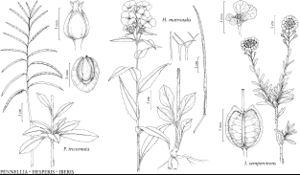Iberis
Sp. Pl. 2: 648. 1753.
Gen. Pl. ed. 5, 292. 1754.
| Taxon | Illustrator ⠉ | |
|---|---|---|
 | Pennellia tricornuta Hesperis matronalis Iberis sempervirens | Yevonn Wilson-Ramsey Yevonn Wilson-Ramsey Yevonn Wilson-Ramsey |
Annuals, perennials, or subshrubs [biennials]; not scapose; glabrous or pubescent. Stems erect or decumbent, often branched distally. Leaves cauline and sometimes basal; petiolate or sessile; basal rosulate or not, sessile [petiolate], blade (somewhat fleshy), margins entire [dentate to pinnatifid]; cauline petiolate or sessile, blade margins entire, dentate, or pinnatifid. Racemes (corymbose), elongated or not in fruit. Fruiting pedicels spreading, divaricate, descending, or ascending, slender. Flowers: sepals ascending [erect], ovate or oblong; petals (zygomorphic, outer [abaxial] pair larger than inner [adaxial] pair), white or pink to purple, obovate [oblanceolate], claw often distinct; stamens tetradynamous; filaments not dilated basally; anthers ovate or oblong, (apex obtuse); nectar glands (4), lateral, 1 on each side of lateral stamen. Fruits sessile, (winged), suborbicular or ovate [obcordate], not torulose, keeled, strongly angustiseptate; valves not veined, (winged), glabrous; replum rounded; septum complete; ovules 2 per ovary; stigma capitate, entire or 2-lobed. Seeds flattened, often winged, ovate [orbicular to reniform]; seed-coat mucilaginous or not when wetted; cotyledons accumbent. x = 7, 8, 9, 11.
Distribution
Introduced; Europe, sw Asia
Discussion
Species 27 (3 in the flora).
Iberis is a well-defined genus readily distinguished by having often corymbose infructescences, zygomorphic flowers, angustiseptate and often distally winged fruits, and exclusively accumbent cotyledons. N. H. Holmgren (2005b) erroneously indicated that the cotyledons in Iberis are incumbent.
All three species treated here are ornamentals that sometimes escape from cultivation. Their distributions are based on verified records, but it is very likely that the species are more widely naturalized than the records show.
Selected References
None.
Lower Taxa
Key
| 1 | Perennials or subshrubs (with sterile shoots). | Iberis sempervirens |
| 1 | Annuals (without sterile shoots) | > 2 |
| 2 | Racemes considerably elongated in fruit; abaxial petals 5-8 mm; styles 0.8-2 mm; cauline leaf blades: margins pinnatifid or dentate. | Iberis amara |
| 2 | Racemes not elongated in fruit; abaxial petals 10-16 mm; styles 2-4.5 mm; cauline leaf blades: margins entire. | Iberis umbellata |
"not" is not a number. "elongated" is not a number."thick" is not a number.